FAQ
Cara Registrasi Akun
Apakah dikenakan biaya untuk menjadi pembeli di HAVA.id?
Tidak dikenakan biaya sama sekali.
Apakah saya bisa melakukan transaksi tanpa melakukan registrasi terlebih dahulu?
Anda harus melakukan registrasi terlebih dahulu. Setelah itu, Anda bisa melihat harga produk untuk melanjutkan transaksi.
Bagaimana cara untuk menjadi pembeli dan registrasi di HAVA.id?
Untuk menjadi pembeli di HAVA.id, berikut langkah-langkahnya :
1. Klik ikon Akun pada sebelah kanan atas pada laman website hava.id atau kunjungi https://hava.id/register.

2. Masukkan data-data yang diperlukan saat melakukan registrasi, lalu klik Daftar Sekarang.
3. Mohon pastikan Nama dan Email yang anda masukan sudah sesuai dan tidak terdapat kesalahan pada saat penulisan karena Nama dan Email Akun tidak dapat diubah.
4. Pastikan anda mengunggah dokumen legalitas perusahaan dengan benar.
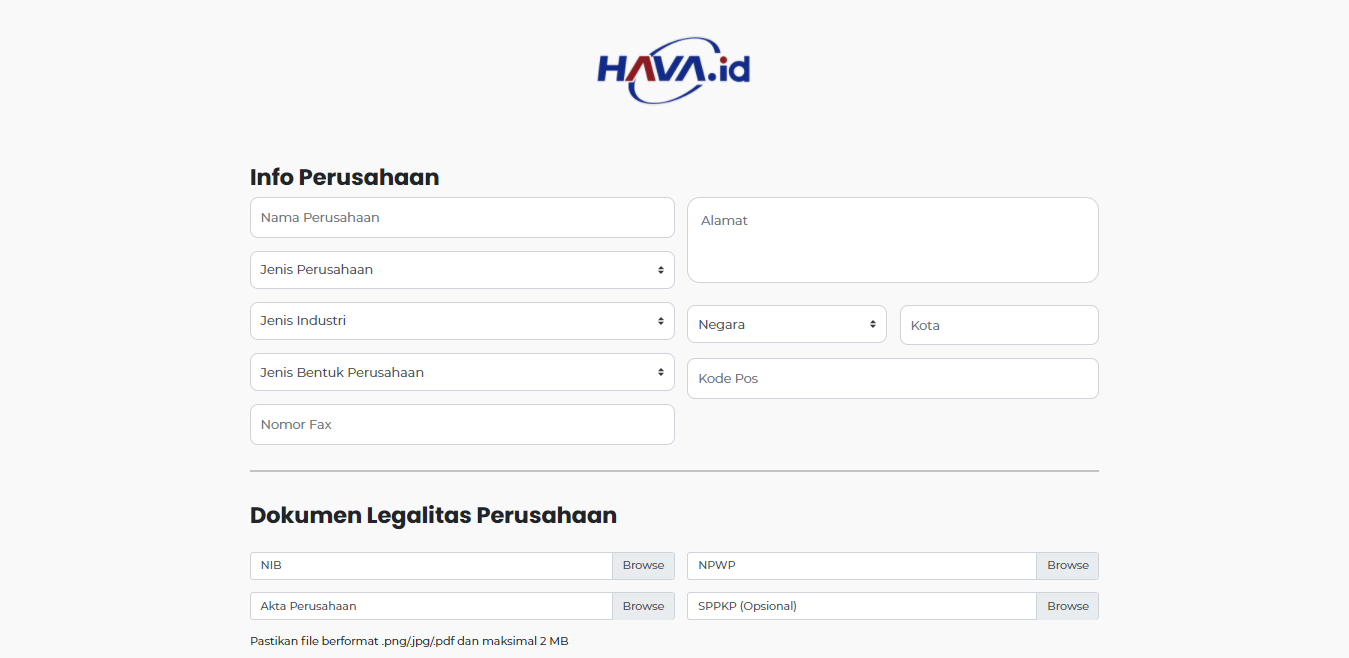
5. Akan muncul notifikasi "Register Berhasil, Silahkan Tunggu Tim Hava Untuk Mengaktifkan Akun Anda".
6. Tim HAVA.id akan memverifikasi data-data yang anda masukkan ketika registrasi.
7. Anda akan menerima email dari HAVA.id bahwa akun anda selesai diverifikasi oleh admin
8. Selamat! Akun anda berhasil dibuat.
Cara Melakukan Login
Untuk melakukan Login, kamu dapat melakukannya dengan cara click ikon User ada bagian kanan atas di halaman awal hava.id atau kamu dapat mengunjungi link berikut ini https://hava.id/login .
Masukkan email dan password anda dengan benar, kemudian click tombol "Login".
Sistem akan memverifikasi akun anda dan mengarahkan anda ke halaman utama.
Lupa Password?
Bagaimana apabila saya lupa password akun HAVA.id?
Jangan khawatir, anda dapat mengganti password anda
Bagaimana cara untuk mengganti password akun saya?
Untuk mengganti password lama anda menjadi password yang baru, anda dapat mengikuti langkah-langkah berikut ini :
- Pada halaman login, click link "Forget your password?".
- Isi alamat email yang anda gunakan saat registerasi.
- Sistem akan mengirimkan link ke alamat email yang anda masukkan.
- Buka email dari hava.id kemudian, click "Reset Password".
- Masukkan password baru yang anda inginkan.
- Selesai.
Cara Memesan
Bagaimana cara melakukan pemesanan atau berbelanja di HAVA.id?
Cukup mudah, ikuti langkah-langkah berikut ini:
1. Cari dan Pilih produk yang diinginkan.
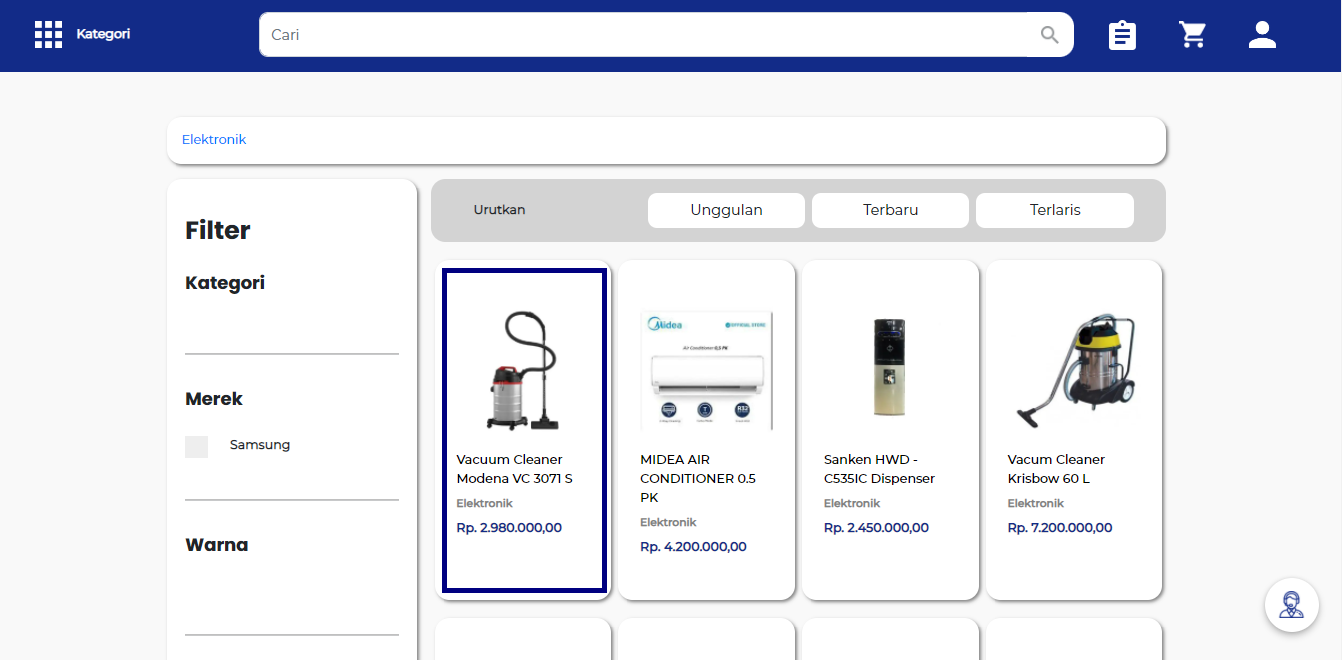
2. Klik tombol "Order Now"

3. Masukkan alamat pengiriman dengan benar, kemudian tekan tombol "Order"
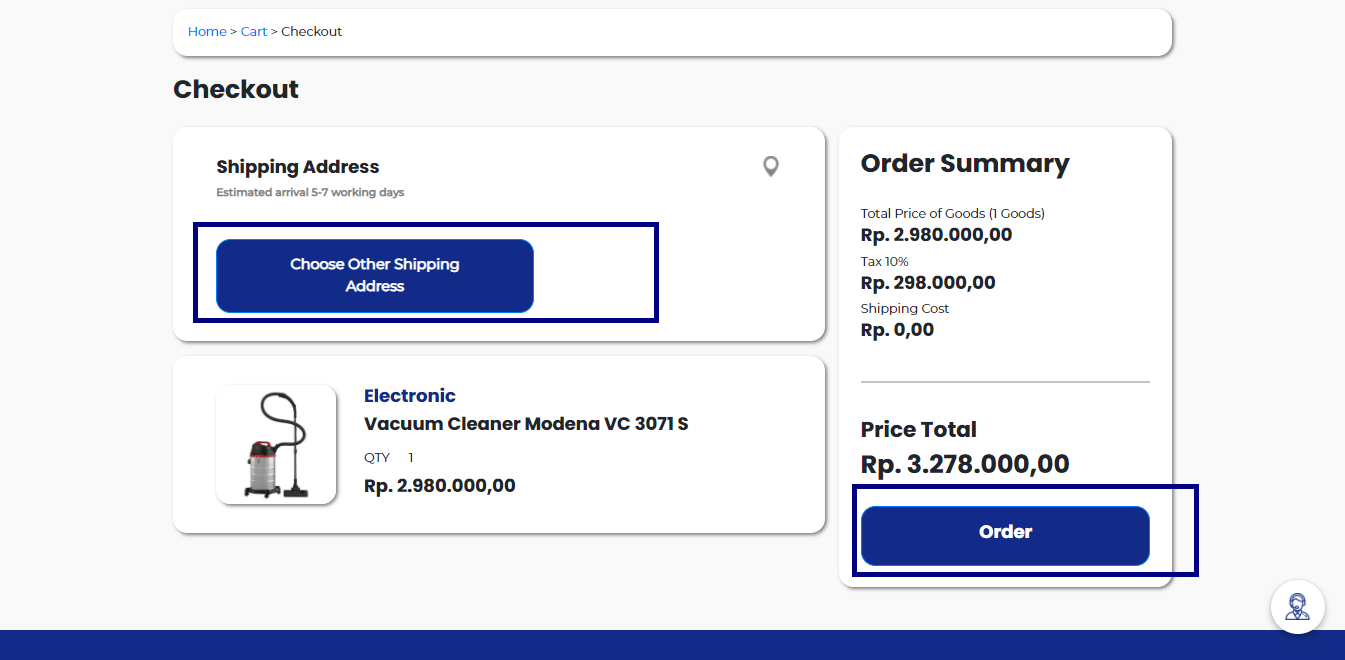
4. Selamat, pemesanan anda telah diterima dan akan diproses oleh admin. Anda dapat melihat detail pemesanan anda dengan menekan tombol "Transaksi".
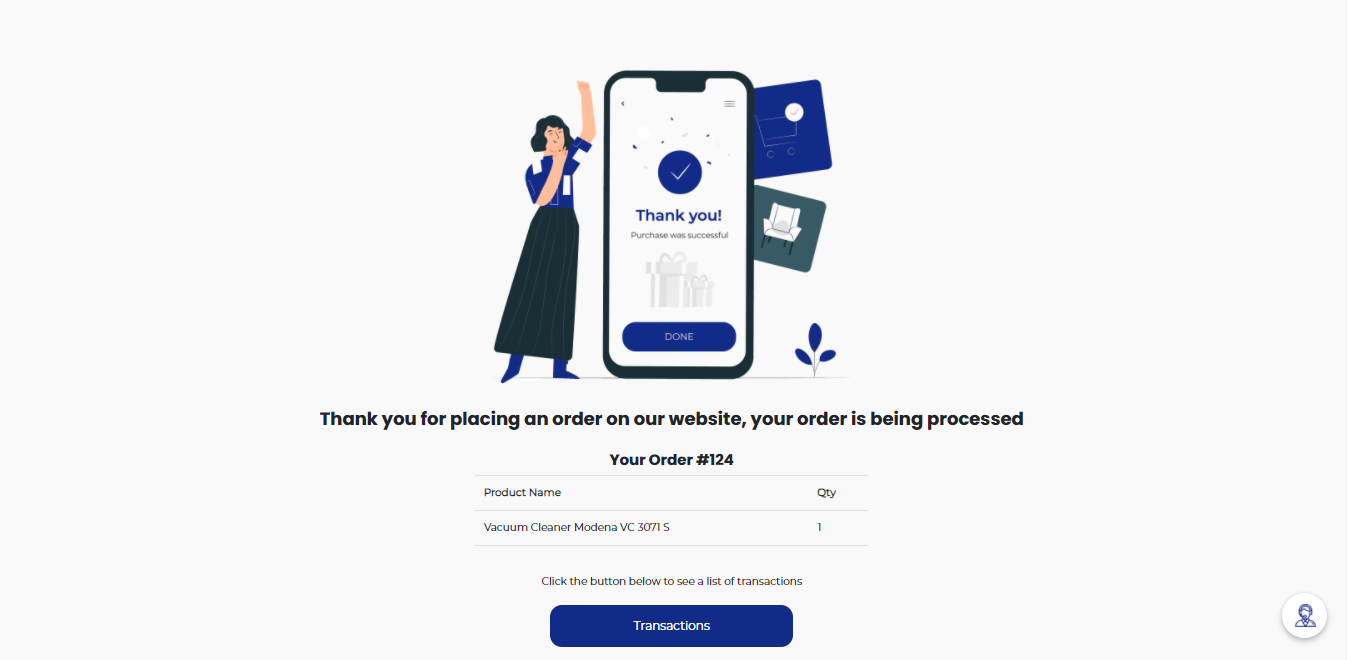
Status Pemesanan
Bagaimana cara mengetahui status pemesanan saya?
Untuk mengetahui status pemesanan, dapat dilihat pada halaman Profil Pembeli dengan cara menekan ikon User atau dapat klik link berikut https://hava.id/profile.

Klik tombol "My Orders" untuk melihat daftar riwayat transaksi
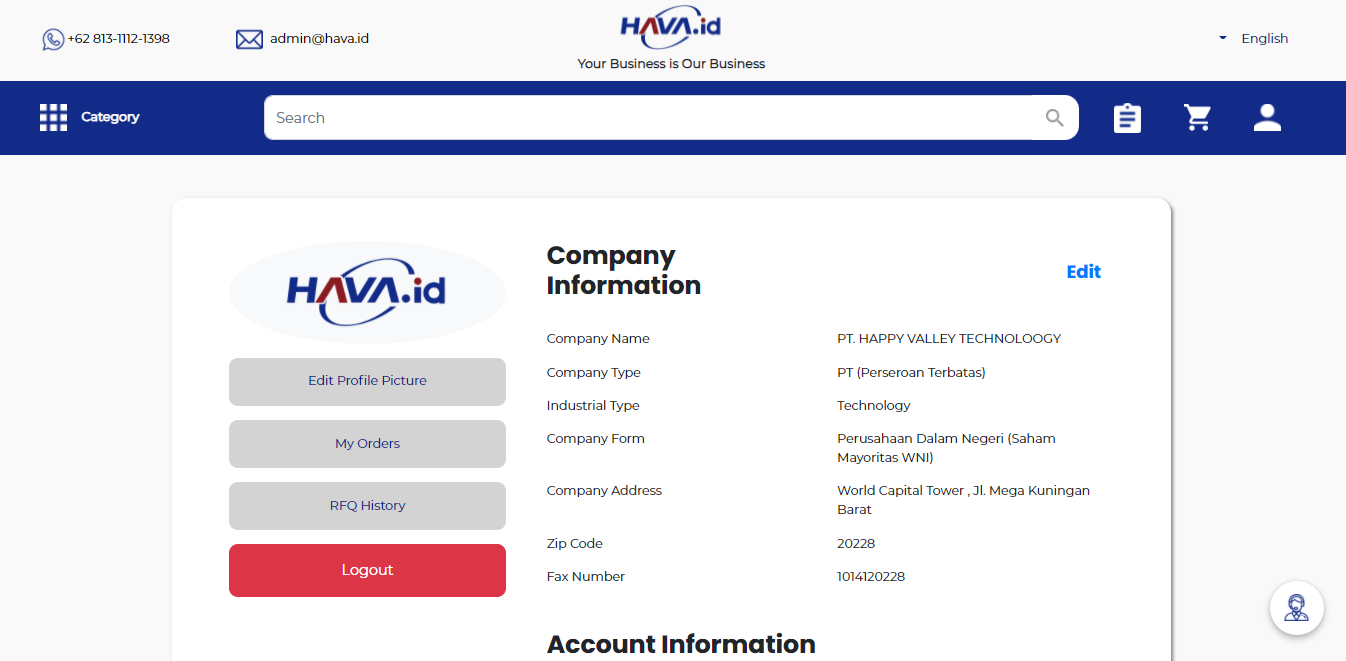
Pada Halaman My Orders ditampilkan daftar riwayat pemesanan anda, klik tombol "Detail" untuk melihat informasi lebih lanjut tentang pesanan anda.
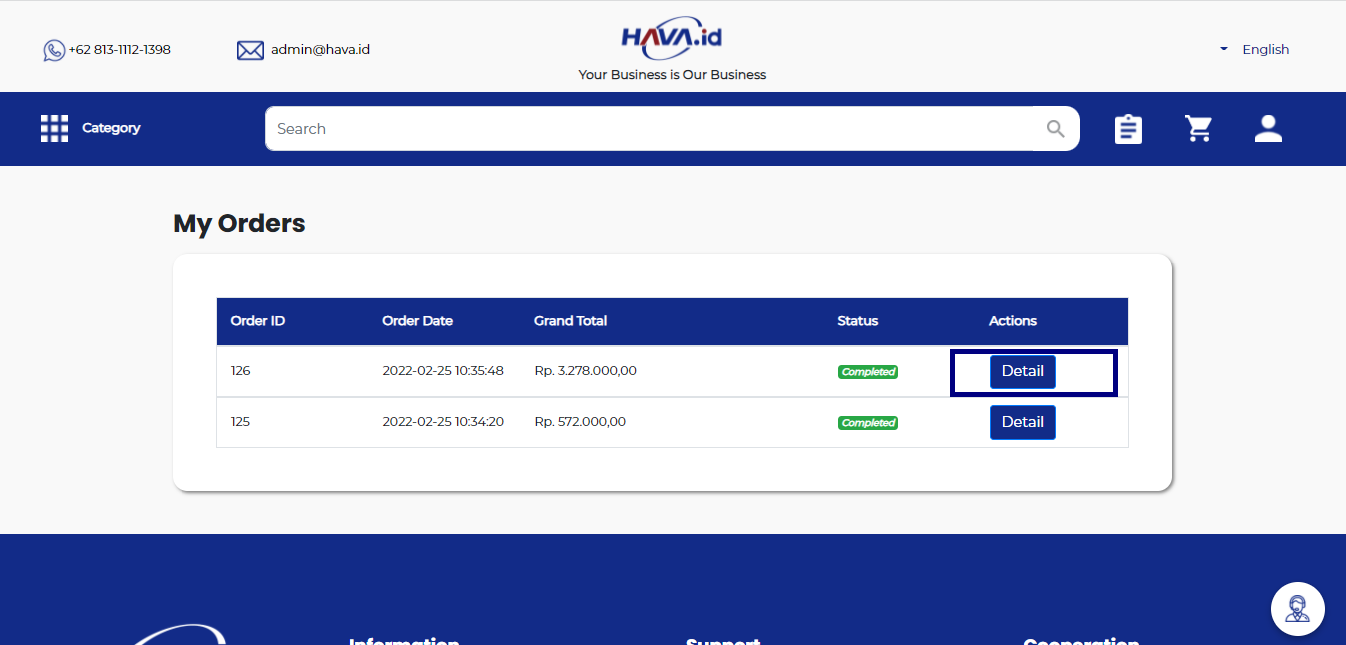
Pada halaman Order Detail ditampilkan informasi-informasi terkait pesanan anda. Anda dapat melihat status pemesanan anda dengan menekan tombol "Order Status".
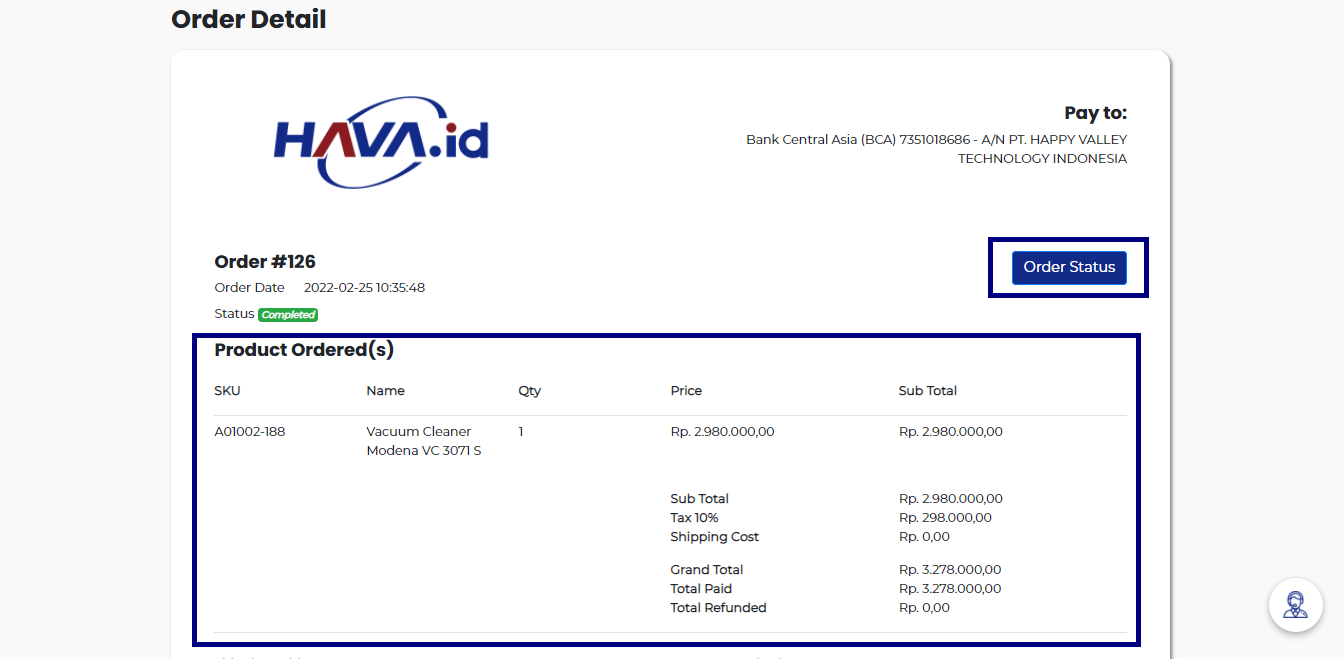
Di halaman ini anda dapat melihat status pemesanan anda.
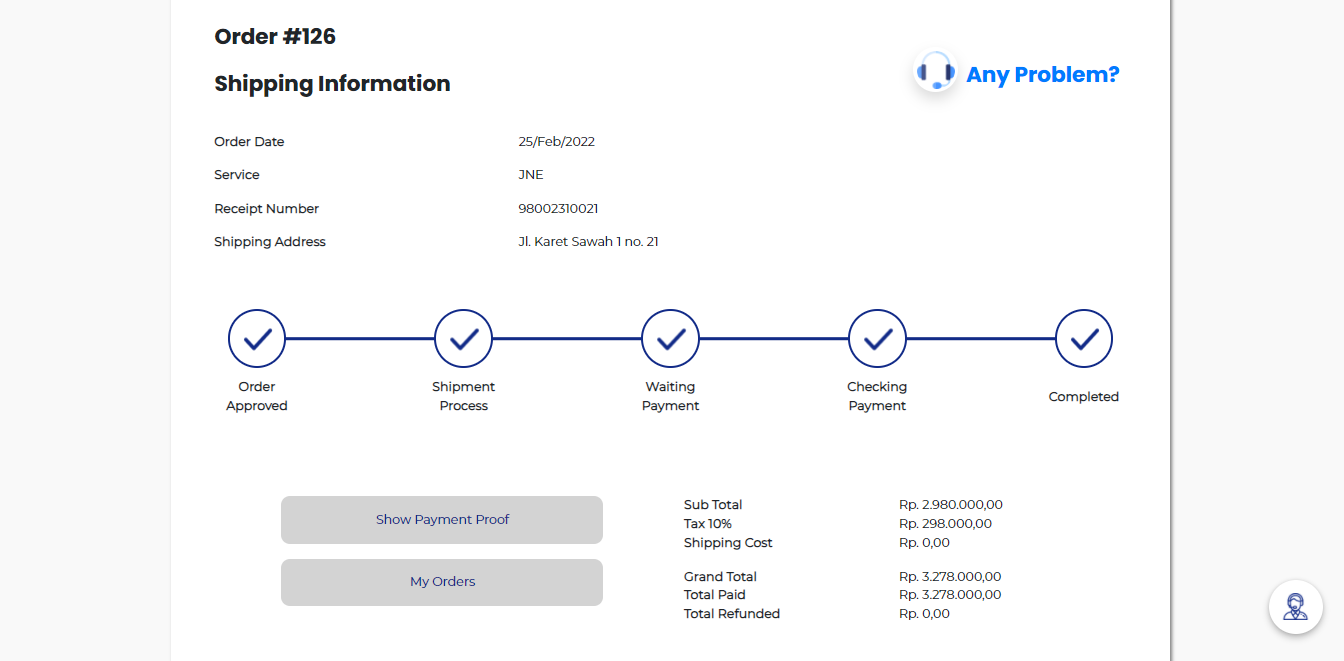
Customer Journey

- Setelah kamu melakukan pemesanan, admin akan memverifikasi dan menyetujui pesanan kamu
- Selanjutnya, pesanan kamu akan dikirim ke alamat yang kamu masukkan
- Pada proses Waiting payment, kamu boleh melakukan pembayaran dan mengunggah bukti pembayaran kamu
- Tim HAVA.id akan melakukan verifikasi terhadap bukti pembayaran yang kamu unggah.
- Selamat proses transaksi kamu telah selesai.
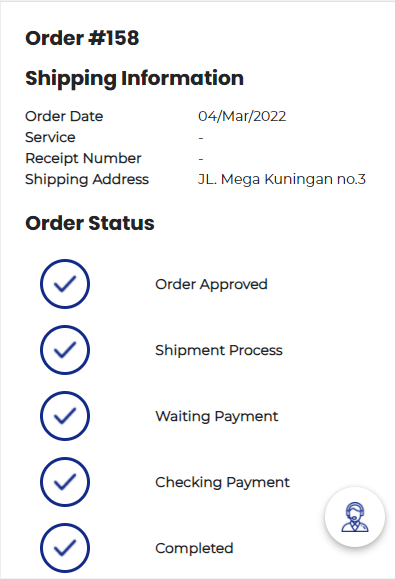
Mobile Version
Dengan HAVA.id transaksi lebih simpel, mudah dan nyaman :)
Business Development Team
Please talk to our business development team.
San san
Business Development Assistant Lead
WhatsApp : (+62) 877 7713 3170
Email : sansan@hava.id
Kenny Gohan Siahaan
Business Development Executive
WhatsApp : (+62) 812 3125 8511
Email : kenny@hava.id
Limit Kredit
Apa itu limit kredit HAVA.id?
Limit kredit merupakan keunggulan dari hava.id dimana kamu sebagai pembeli tidak perlu membayar pemesanan secara langsung namun bisa dengan menggunakan credit limit kamu
Berapa lama term of payment HAVA.id?
Kamu dapat melakukan pembayaran maksimal 30 hari sejak pemesanan kamu disetujui.
Bagaimana cara melihat nominal credit limit saya?
Kamu dapat melihat nominal credit kamu pada halaman my profile
Bagaimana jika credit limit saya kurang untuk melakukan transaksi?
Kamu dapat menghubungi kami di admin@hava.id / wa : 081311121398 untuk pengajuan penambahan nominal credit limit. Untuk melakukan pengajuan penambahan credit limit pastikan kamu telah menyelesaikan seluruh pembayaran.
Bagaimana jika saya terlambat melakukan pembayaran?
Apabila kamu terlambat melakukan pembayaran maka akun HAVA.id kamu akan dibekukan.
Apakah credit limit ada bunganya?
Tidak ada bunga
Penjualan dan Pemasaran B2B Tradisional Menjadi Usang
Sebagian besar tim penjualan dan pemasaran B2B biasanya berfungsi secara "serial", atau linier. Pemasaran melibatkan calon pembeli di awal perjalanan pembelian mereka, memenuhi syarat kesiapan dan kecocokan mereka untuk keterlibatan perwakilan penjualan melalui “pemeliharaan konten” digital. Setelah prospek tersebut ditetapkan sebagai "pemasaran yang memenuhi syarat", penjual individu mengambil alih, mengejar prospek tersebut melalui interaksi langsung atau virtual. Di tengah adalah "handoff", di mana pemasaran menyerahkan tongkat estafet ke penjualan, dan keterlibatan pelanggan online digantikan oleh keterlibatan pelanggan secara langsung.
Bahkan dalam "pendekatan pemasaran berbasis akun" yang lebih maju, "fisika" linier tersebut sebagian besar tetap tidak tertandingi. Pertama pemasaran, lalu penjualan. Atau, lebih tepatnya, keterlibatan digital skala pertama, diikuti oleh interaksi penjual yang ditargetkan. Dan pengejaran selama puluhan tahun untuk “integrasi penjualan dan pemasaran” yang lebih ketat telah berpusat pada kemajuan kesepakatan sepanjang perjalanan itu semulus mungkin, menghilangkan “gesekan” dan menyelaraskan metrik, data, dan terkadang bahkan insentif dan struktur pelaporan untuk memastikan penyerahan dari penjualan digital ke manusia seefisien mungkin.
Maraknya pembelian B2B digital
Selama bertahun-tahun, pembelian B2B telah berkembang secara dramatis menjadi perilaku pembelian yang jauh lebih dominan secara digital, membuat sebagian besar model komersial tersebut tidak hanya ketinggalan zaman, tetapi juga hampir usang.
Dilihat dari data berikut dari penelitian Gartner: Dalam survei pra-pandemi terhadap 750 pemangku kepentingan pelanggan B2B yang terlibat dalam pembelian “solusi” kompleks dalam organisasi mereka, pelanggan melaporkan hanya menghabiskan 17% dari total waktu pembelian mereka untuk berinteraksi langsung dengan tim penjualan pemasok. Sebaliknya, sebagian besar aktivitas pembelian mereka terdiri dari pembelajaran mandiri online (27%), pembelajaran mandiri offline (18%), dan membangun konsensus di berbagai pemangku kepentingan internal dan mitra (masing-masing 22% dan 11%).
Namun, sekecil apa pun, 17% aktivitas pembelian yang dialokasikan untuk interaksi pemasok (baik virtual maupun tatap muka), mewakili semua pemasok, bukan setiap pemasok. Jadi, jika tiga pemasok bersaing untuk mendapatkan peluang yang sama, dapat diasumsikan bahwa pelanggan membagi waktu tersebut kira-kira sama untuk ketiganya, meninggalkan tim penjualan mana pun dengan jendela peluang yang sangat kecil untuk berinteraksi langsung dengan pelanggan tersebut — mungkin 5% atau 6% dari total waktu pembelian jika mereka beruntung.
Bagi banyak pemimpin penjualan, jendela interaksi langsung yang sangat kecil itu merupakan satu-satunya tantangan terbesar yang dihadapi tim penjualan mereka saat ini, kurangnya akses secara keseluruhan — dan oleh karena itu kurangnya kesempatan — untuk secara material memengaruhi pertimbangan pembelian dan membengkokkan preferensi pelanggan ke penawaran unik perusahaan mereka.
Seperti yang dikatakan oleh salah satu kepala penjualan, "Kami memiliki sangat sedikit 'kelelawar' untuk benar-benar memengaruhi perilaku pembelian pelanggan." Dengan kata lain, perjalanan pembelian B2B yang khas saat ini membuat tim penjualan pemasok sangat sedikit “area permukaan” untuk penjualan yang sebenarnya.
Multi-channel buying
Sebaliknya, pembeli B2B saat ini sangat bergantung pada informasi digital untuk mendukung kemajuan di seluruh perjalanan pembelian mereka. Dalam survei terhadap lebih dari 1.000 pembeli B2B yang terlibat dalam pembelian yang kompleks, responden melaporkan menggunakan saluran digital — khususnya situs web pemasok itu sendiri — dengan frekuensi yang hampir sama dengan perwakilan penjualan pemasok untuk mengumpulkan informasi yang diperlukan untuk menyelesaikan berbagai “pekerjaan” pembelian. misalnya, Identifikasi Masalah, Eksplorasi Solusi, Pembuatan Persyaratan, dan Pemilihan Pemasok. Pada akhirnya, sebagian besar pelanggan menjadi agnostik mengenai di mana mereka menemukan informasi yang diperlukan untuk memajukan pertimbangan pembelian.
Dalam pengertian ini, bagi para pemimpin penjualan yang ingin “mendapatkan kembali akses pelanggan”, ternyata pelanggan tidak pernah benar-benar menginginkan akses penjual. Sebaliknya, mereka mencari percakapan penjualan bukan demi percakapan itu sendiri, tetapi sebagai sarana praktis untuk memperoleh informasi yang diperlukan untuk menyelesaikan serangkaian pekerjaan pembelian tertentu. Sekarang banyak dari informasi itu tersedia secara online, perwakilan penjualan tidak lagi menjadi saluran ke pelanggan, tetapi saluran ke pelanggan. Dan pelanggan "memilih dengan kaki mereka," membuat banyak perwakilan penjualan berjuang untuk memberikan nilai yang cukup unik untuk mendapatkan waktu dan upaya tambahan dari interaksi penjualan orang-ke-orang.
Terlepas dari perjuangan penjual individu untuk tetap relevan, bagaimanapun, pemimpin organisasi akan menemukan perilaku pembelian agnostik saluran pelanggan sebagai pelajaran yang sangat penting untuk kesuksesan komersial di masa depan: Membantu pembeli B2B saat ini membeli bukanlah tantangan penjualan, hampir seperti tantangan informasi (atau, alternatifnya, peluang informasi). Perusahaan yang memberikan informasi paling mendesak kepada pelanggan, khususnya melalui saluran yang paling mereka sukai, berada dalam posisi yang jauh lebih baik untuk mendorong kesuksesan komersial dalam lanskap komersial digital yang berkembang pesat saat ini.
www.hava.id
HAVA.id 1st Anniversary
It’s been 1 year since HAVA.id first opened its doors back in 2022. Our mission has always been to simplify the procurement process, planning, sourcing, and order management with our open 360° E-procurement Solutions Platform, Professional Fulfillment, and B2B Financing.
We have been a leading provider of B2B procurement solutions and professional fulfillment services since the day we are launching, with nationwide coverage. We provide a full range of products and solutions for your business at the most competitive pricing.
What Is Business-to-Business (B2B)?
What Is Business-to-Business (B2B)?
Business-to-business (B2B), also called B-to-B, is a form of transaction between businesses, such as one involving a manufacturer and wholesaler, or a wholesaler and a retailer. Business-to-business refers to business that is conducted between companies, rather than between a company and individual consumer. Business-to-business stands in contrast to business-to-consumer (B2C) and business-to-government (B2G) transactions.
Understanding Business-to-Business (B2B)
Business-to-business transactions are common in a typical supply chain, as companies purchase components and products such as other raw materials for use in the manufacturing processes. Finished products can then be sold to individuals via business-to-consumer transactions.
In the context of communication, business-to-business refers to methods by which employees from different companies can connect with one another, such as through social media. This type of communication between the employees of two or more companies is called B2B communication.
Special Considerations
Business-to-business transactions require planning to be successful. Such transactions rely on a company’s account management personnel to establish business client relationships. Business-to-business relationships must also be nurtured, typically through professional interactions prior to sales, for successful transactions to take place.
Traditional marketing practices also help businesses connect with business clients. Trade publications aid in this effort, offering businesses opportunities to advertise in print and online. A business’s presence at conferences and trade shows also builds awareness of the products and services it provides to other businesses.
WHAT IS A B2B MARKETING STRATEGY?
WHAT IS A B2B MARKETING STRATEGY?
A marketing strategy is a top-level plan for reaching a defined target group and turning them into customers of their products or services. A good marketing strategy revolves around the very foundation of the company: its core values, brand positioning, target market and target group. Marketing centric companies put their marketing strategy on a level with the companies’ strategic goals. In such customer-centric companies, all other strategies, like the sales strategy, digitalization strategy, market entry strategy, R&D strategy and alike, are derived from the marketing strategy.
STRATEGY IN THE BIGGER PICTURE
The terminology strategy is easy to understand and yet hard to grasp in detail. Aim, tactic, plan, vision, and strategy are often used synonymously. A grave mistake. Here’s an easy to remember mnemonic.
- Vision: Travel the world and enjoy diverse cultures
- Aim: Visit the town behind the mountains
- Strategy: Take the river
- Tactic: Use a boat
- Plan: Row with two paddles simultaneously
BENEFITS OF HAVING A MARKETING STRATEGY
The benefits of a marketing strategy are a clear path to meet your aims and fulfill your vision. The tactics and the plan to bring your tactics to life derive from the marketing strategy. This basic principle holds for all market types, including B2B and B2C markets. Therefore, a B2B Marketing Strategy has the same foundation as a B2C Marketing Strategy. The vision, aim, strategy details, tactic, and plan are different from company to company and depend on many influencing factors.
DIFFERENT B2B MARKETING STRATEGY TYPES
A marketing strategy is inseparably linked to the market on which the company acts. The market centers on the company strategy and main company aim.
- Differentiation
The company targets a mass market and aims to differentiate its portfolio from the competition. The concept of “unique selling proposition – USP” describes criteria making a product or service stand out. A highly differentiated portfolio allows higher prices because it fulfills customer needs better than the competition. - Focus
A clearly defined, very specific niche market typically has less competition. The high degree of specialization increases market entry barriers and make a well-developed niche profitable. Instead of competing head to head in a mass market, a niche strategy aims to develop outstanding knowledge of this narrow-defined market segment.
- Cost Leadership
This resource- and efficiency-based strategy intends to provide the best price-value ratio. The lowest possible costs allow low prices for the same quality as the competition. This strategy works well in price-sensitive markets in which cost advantages are long-standing.
What Is B2B Procurement And Why Is It Important?
What Is B2B Procurement And Why Is It Important?
Are you a business owner or decision-maker wondering why B2B procurement is crucial for your organization’s success? Procurement in the B2B industry is more than just buying products and services from vendors. It involves strategic planning, negotiations, supplier management, and risk mitigation. In this blog post, we’ll take a deep dive into what B2B procurement means and why it matters for your business growth. Get ready to discover how implementing an effective procurement strategy can give you a competitive edge in today’s fast-paced market!
What is B2B procurement?
procurement is the process of acquiring goods and services from suppliers. In most cases, procurement is conducted through contracts with providers. The goal of procurement is to find the best solution for a company while ensuring that costs are reasonable and the quality of service meets expectations.
Procurement can be beneficial for both companies and suppliers. Companies can save money by choosing the best supplier for their needs, while suppliers can earn a fair wage and become well-known in the industry. Furthermore, good procurement practices can lead to stronger relationships between companies and suppliers, which can benefit both parties in the future.
There are a number of factors to consider when conducting procurement: pricing, quality, delivery time, lead time, and customer service. Companies should also take into account their budget and business objectives when selecting a supplier. Ultimately, good procurement planning will help companies get the best possible value for their investment while meeting their specific needs.
How does B2B procurement work?
B2B procurement is the process of acquiring goods and services from suppliers outside of your company. There are many reasons why you might want to use B2B procurement, including gaining access to new products and services, reducing costs, and building partnerships.
When you start the procurement process, you need to create a purchasing plan. This plan will outline what you need and when you need it. You also need to identify your target market and research your competitors. After you have created your purchasing plan, you need to find a supplier that meets all of your requirements. Once you have found a supplier, you will need to negotiate a contract with them. Finally, once the contract is signed, you will need to monitor the performance of the supplier
Why is B2B procurement important?
Business-to-business procurement (B2B) refers to the buying and selling of goods and services between businesses. Procurement is a process that enables businesses to acquire the resources they need in order to operate effectively.
There are many reasons why B2B procurement is important. First, it helps businesses save money by pooling their resources and purchasing items in bulk. Second, it allows them to connect with suppliers who have the expertise they need. Third, B2B procurement can help companies build relationships with other businesses, which can lead to new business opportunities. And finally, it can help companies improve their overall competitiveness by helping them find better solutions to their problems.
Procurement is an important part of any business’s operations, and B2B procurement should be considered a top priority for any company looking to improve its performance.
10 Benefits of a B2B Ecommerce Website
10 benefits of a B2B ecommerce website
Our personal shopping experiences have shaped our expectations for B2B buying experiences. Consumers have become accustomed to seamless, Amazon-like shopping experiences in their personal lives. According to a 2018 Forrester survey, B2B buyer appetite for digital ordering tools is increasing. More than 70% of B2B buyers find buying from a website more convenient than buying from a sales representative.
Business-to-business ecommerce websites provide a way for your customers to purchase your products online, and a host of other benefits to your organization. Imagine your customers, dealers or distributors seeing both their online and offline orders in one place, managing their orders, budgets, seeing their pricing and available promotions through an online experience. Also, with the integration of a purpose-built B2B ecommerce digital experience platform, businesses can maximize efficiency, increase sales and improve customer experience.
10 benefits of a branded ecommerce site with a B2B engine:
1. Scalability
An effective B2B ecommerce digital experience platform will enable your organization to grow and scale easily to meet market demand and customer needs, by opening new sales channels and continuously reaching new market segments.
By creating and testing compelling content for your targeted B2B buyers, you can deliver value and quickly respond to changes in the market. Also, by adopting extensible B2B ecommerce cloud solutions, you can revamp your existing technology and significantly improve your marketing and merchandizing capabilities.
2. Improved efficiency & productivity
Through integration to the enterprise resource planning (ERP) and other back-end business systems, ecommerce provides marked efficiencies for B2B organizations. Since customers can order online at their convenience, businesses can focus on the actual customer service functions rather than simply being order takers.
Also, automated ordering and workflows eliminate the need to reconfigure data in independent systems, thereby reducing the possibility of errors. This further improves the efficiency of shipping processes and increases order throughput.
3. More customers
A B2B ecommerce site with public-facing catalog pages is a powerful tool to reach new B2B customers. Your future buyers not only prefer to shop online, but will demand it. As B2B buyers head online to compare products and find the best prices, manufacturers and distributors can leverage the power of search engines to connect with them. By developing a responsive B2B ecommerce site with rich SEO-friendly content, you can locate new visitors and convert them into customers.
4. Improved brand awareness
A B2B ecommerce platform provides your business with an online presence, thus giving you control over your brand. This allows you to promote, grow and strengthen your brand both locally and internationally.
Although other external B2B market channels may generate additional brand awareness benefits, your branded ecommerce website is the main marketing tool for a sustained online presence and visibility.
Developing SEO-friendly content for your ecommerce site is a fast way to improve your site’s search engine ranking and improve the likelihood that your target audience will know who you are.
5. Increased sales
A B2B ecommerce site not only helps you reach new customers, it also allows you to easily implement an automated cross-sell and upsell recommendation program. With this, you can increase sales by offering relevant suggestions to customers on the site and encouraging them to purchase related items, or items with more features and functionalities.
A well-designed ecommerce platform provides the right information to your customers, thus facilitating the ordering process. Also, by providing self-service capabilities, B2B ecommerce websites allow customers to order or reorder easily based on previous purchases, including negotiated prices and personalized preferences. This not only increases sales, but also improves the mean order values.
6. Analytics capability
B2B ecommerce provides a perfect platform for organizations to launch comprehensive analytics campaigns. Through ecommerce, organizations can easily measure and evaluate marketing campaigns, sales effectiveness, product mix, inventory turns, customer sales effectiveness and customer engagement. Google Analytics offers ecommerce tracking, but integrating analytics with your ERP as well gives you much more valuable data with actionable insights.
7. Customer-centric experience
Amazon.com sets the standard for providing an exceptional ecommerce experience and today’s online shopper expects an Amazon-like experience whether they are shopping for business or pleasure.
While there are certainly differences in experiences for retail shoppers and B2B buyers, B2B organizations still need to employ intuitive design, rich content and interactive functionality in their websites in the way of product recommendations and trends based on previous searches, merchandise based on holidays or themes and easy access to past orders, account settings, profile and wishlists.
8. Exceptional customer service
Ecommerce provides an exceptional opportunity for B2B organizations to improve their customer service initiatives. Ecommerce sites can provide access to self-serve portals with customers’ account, order, history and tracking information. Through integration with an organization’s ERP system, a robust ecommerce site can display customer-specific products, services and pricing based on customer login credentials.
9. Improved sales engagement
Your physical sales team will also benefit from the launch of a comprehensive ecommerce effort. A B2B ecommerce site or portal will improve your sales teams’ visibility into customer orders, pricing and history while traveling or working remotely.
With automated inventory management and order tracking, you can synchronize data across your ecommerce channels and provide accurate updates to your customers. This is a proven way to promote transparency, ensure faster delivery and improve customer experience.
10. Multi-site capability
While acknowledging that today’s shopping tendencies are mostly non-linear, it is important to provide an omnichannel experience to your customers with a B2B ecommerce platform. Usually, B2B buyers move from one device to another and across multiple platforms as they search for the products they need.
Launching channel-specific or co-branded ecommerce sites is easy with the right B2B ecommerce platform. This capability allows you to offer co-branded websites or microsites for each of your distributors or key clients as well as allow for sites that cater to a specific international audience by presenting content in alternate languages or currencies.
What Is B2B, and How Does It Differ From B2C and DTC?
What Is B2B, and How Does It Differ From B2C and DTC?
Without B2B companies and the supply chain, the goods and services we take for granted as consumers and business owners wouldn't exist.
- B2B companies create products and services for other businesses, organizations and charities.
- B2B businesses have unique challenges, including cash flow management, and must continually innovate and maintain customer loyalty.
- To maximize profits and improve market share, B2B companies should consider optimizing their websites and try lead-generation services that help them reach decision-makers.
- This article is for business owners and aspiring entrepreneurs who want to better understand the B2B business model.
B2B is short for “business to business.” It’s a business model in which the companies involved create products and services for other businesses and organizations. B2B companies can include software as a service (SaaS), marketing firms, and businesses that create and sell various supplies.
No matter your business’s size, at some point you’ll need to purchase products or services from B2B companies. We’ll explore the B2B business model and how B2B businesses can maximize their profits and market share.
What is B2B?
In the business-to-business model, businesses and organizations exchange goods and services. For example, one company may contract with another business to provide the raw materials needed to manufacture a product.
Another business may need to purchase products from another to stock their shelves, while other companies hire businesses to promote their products and services, insure their operations, design their logo, or write website content.
Consumers aren’t a direct factor in B2B transactions, but they’re a critical component of why B2B companies work together.
B2B isn’t the only business model involved in the supply chain. While B2B companies sell products and services to other private businesses, public-sector organizations, and charities, B2C (business-to-consumer) – or DTC (direct-to-consumer) – companies sell products and services directly to consumers.
B2B MARKETING STRATEGIES FOR TECHNOLOGY COMPANIES
B2B MARKETING STRATEGIES FOR TECHNOLOGY COMPANIES
In this chapter, we’ll explore several strategies specific to B2B marketing. The focus remains on the high-tech industry. We’ll dive into the power of inbound marketing, the effectiveness of account-based marketing, and the opportunities available when targeting a global niche market. Additionally, I show you the importance of brand marketing. And finally, how virtual and augmented reality can enhance your B2B tech marketing efforts.
Moreover, we’ll explore the importance of identifying target market segments. Thought leadership is a great way to establish a company as an industry expert.
Let’s get started on exploring these strategies in detail. Learn how they can help your technology company achieve marketing success.
These 6 strategies are essential to stand out in a crowded marketplace:
- Identifying target market segments
- Thought Leadership
- Inbound marketing
- Account-based Marketing
- Global Niche Marketing
- Virtual and Augmented Reality
IDENTIFYING TARGET MARKET SEGMENTS
The first step of market segmentation is to understand your customers’ specific needs and pain points. Then break it down into different market segments. This approach creates more effective marketing strategies. They resonate with the target audience.
Targeting everyone is not a strategy. It is a waste of money and time.
One way to identify target market segments is through market research. This can include surveys, interviews, and focus groups with current and potential customers. Market research can either be primary (doing it yourself) or secondary (e.g., buying research and interpreting them yourself). Market research provides valuable insights into market segments’ demographics, behaviors, and pain points.
Another approach is to analyze data from existing customers. The aim is to gain insights into which segments are most valuable and what messaging resonates. Look at customer lifetime value, purchase history, and engagement with marketing campaigns. For example, you may find a specific product popular among a particular age group or geographic region.
The final step is to create specific content for each market segment. This can include tailored messaging, targeted content, and customized product offerings.
Identifying target market segments is crucial in achieving B2B marketing success. Yet, the rule is “customize where necessary, standardize where possible.” Meaning, do not hyper-segment your market. It will be hard to provide specific content for many segments.
Benefits Of Using B2B For Corporate Procurement
Benefits Of Using HAVA.id For Corporate Procurement
B2B (business-to-business) platforms are online E-commerce Platform that facilitate transactions between businesses. Here are some reasons why businesses should use B2B platforms:
- Increased visibility: By listing products or services on a HAVA.id B2B E-commerce platform, businesses can reach a wider audience of potential customers. B2B platforms often have a large user base of businesses looking for products or services, which can help increase visibility and brand awareness.
- Streamlined procurement: HAVA.id B2B E-commerce platform can simplify the procurement process for businesses by providing a single platform for sourcing and purchasing goods and services. This can save time and reduce costs associated with traditional procurement methods.
- Improved efficiency: HAVA.id B2B E-commerce platform can automate many processes associated with procurement, such as order processing, invoicing, and payment. This can improve efficiency and reduce errors associated with manual processes.
- Access to a wider range of products and services: HAVA.id B2B E-commerce platform can offer businesses access to a wider range of products and services than they would have access to through traditional channels. This can help businesses find new suppliers and products, and potentially lower costs.
- Data insights: HAVA.id B2B E-commerce platform can provide businesses with data insights on purchasing trends, product demand, and supplier performance. This can help businesses make more informed decisions about their procurement strategy.
Overall, HAVA.id B2B E-commerce platform offer many benefits for businesses looking to streamline their procurement processes, reduce costs, and improve efficiency. By leveraging the power of technology and online marketplaces, businesses can access a wider range of products and services, while also gaining valuable data insights to inform their procurement strategy.
Key Requirement for Procurement Team
Key Requirement for Procurement Team
The procurement team is responsible for managing the process of acquiring goods and services for a business. Here are some key needs of a procurement team:
- Supplier management: The procurement team needs tools and systems to effectively manage relationships with suppliers. This includes the ability to assess and select suppliers, negotiate contracts and pricing, monitor supplier performance, and address any issues or disputes that may arise.
- Sourcing capabilities: Procurement teams need access to a wide network of suppliers and vendors to source the goods and services required by the business. They need tools and resources to identify potential suppliers, evaluate their capabilities, and obtain competitive bids or proposals.
- Contract management: Efficient contract management is crucial for procurement teams. They need systems and processes to draft, review, negotiate, and store contracts with suppliers. This includes tracking contract terms, renewal dates, and compliance requirements.
- Purchase requisition and approval: The procurement team needs tools to receive purchase requests from different departments within the organization, evaluate them for compliance and budget availability, and obtain necessary approvals before proceeding with the purchase.
- Supplier performance evaluation: Evaluating supplier performance is essential for ensuring quality, timeliness, and cost-effectiveness. Procurement teams require mechanisms to collect feedback from internal stakeholders, track key performance indicators (KPIs), and conduct periodic supplier assessments.
- Analytics and reporting: Procurement teams need access to data and analytics tools to gain insights into spending patterns, supplier performance, cost savings, and other key metrics. This enables them to identify opportunities for process improvement, cost reduction, and strategic decision-making.
- Risk management: Managing risks associated with the procurement process is crucial. Procurement teams need to identify and mitigate risks related to supplier reliability, market volatility, regulatory compliance, and other factors that could impact the business's supply chain.
- Integration with finance and accounting systems: Procurement activities generate financial transactions that need to be seamlessly integrated with the organization's financial and accounting systems. This ensures accurate tracking of expenses, invoice processing, and budget management.
By addressing these needs, procurement teams can effectively carry out their responsibilities and contribute to the overall success of the organization's supply chain and operations.
How To Simplify The Corporate Procurement Cycle
How to simplify the corporate procurement cycle
Simplifying the procurement cycle can help streamline the procurement process, save time, and improve efficiency. Here are some steps you can take to simplify the procurement cycle:
- Standardize processes: Establish standardized procedures and workflows for the procurement cycle. Clearly define roles and responsibilities, document the steps involved, and communicate the process to all stakeholders. This consistency will help streamline the procurement cycle and reduce confusion.
- Centralize procurement activities: Centralize procurement activities in a single system or platform. This can include using a procurement software or an enterprise resource planning (ERP) system. By centralizing data and processes, you can eliminate manual tasks, reduce duplicate efforts, and improve visibility into procurement activities.
- Automate repetitive tasks: Identify repetitive and manual tasks within the procurement cycle and automate them using technology. This can include automating purchase requisitions, approvals, purchase orders, and invoice processing. Automation reduces the chance of errors, speeds up the process, and frees up time for procurement professionals to focus on more strategic activities.
- Implement self-service portals: Provide self-service portals or catalogues for employees to directly request and order items. By empowering employees to make their own procurement requests within predefined guidelines, you can reduce the workload on the procurement team and streamline the requisition process.
- Leverage e-procurement tools: Use e-procurement tools or platforms such as HAVA.id B2B E-procurement platform to facilitate online purchasing, vendor management, and contract management. These tools can simplify the procurement cycle by digitizing documents, automating processes, and providing real-time access to information and analytics.
- Streamline supplier management: Evaluate and consolidate your supplier base. Working with a smaller number of trusted suppliers can simplify the procurement process, reduce administrative overhead, and improve supplier relationships. Establish clear criteria for supplier selection and regularly assess supplier performance to ensure they meet your organization's needs.
- Embrace electronic documentation: Move away from paper-based processes and transition to electronic documentation. Digital files are easier to store, search, and share, reducing the need for physical storage space and manual document handling. Electronic documentation also enables better tracking and auditing of procurement activities.
By implementing these strategies, you can simplify the procurement cycle, reduce manual effort, and enhance overall efficiency in your procurement operations.
Finding The Best Price For Procurement
Finding the best price for procurement involves a strategic approach that takes into account various factors. Here are some steps to help you find the best price for procurement:
- Conduct market research: Begin by researching the market to gather information about the average prices, trends, and pricing models for the products or services you are procuring. This will give you a baseline understanding of what to expect and enable you to negotiate effectively.
- Identify multiple suppliers: Identify and reach out to multiple suppliers who can provide the products or services you need. Having multiple options allows you to compare prices and negotiate for the best deal.
- Request for Quotation (RFQ): Send out a Request for Quotation (RFQ) to the selected suppliers. The RFQ should clearly specify your requirements, quantity, quality standards, delivery terms, and any other relevant details. Ask suppliers to provide their best price offers in response to the RFQ.
- Compare offers: Once you receive the quotations from different suppliers, compare them based on factors such as price, quality, delivery time, payment terms, warranties, and after-sales support. Consider the total cost of ownership rather than solely focusing on the upfront price.
- Negotiate: Engage in negotiations with the suppliers to get the best price. Use the information gathered during market research and the competitive offers received to leverage your position. Negotiate on factors such as price, volume discounts, payment terms, and additional value-added services.
- Consider long-term agreements: For recurring procurement needs, consider entering into long-term agreements or contracts with suppliers. Long-term contracts can often lead to better pricing, as suppliers value ongoing business relationships and stability.
- Leverage technology: Utilize e-procurement tools or platforms such as HAVA.id that provide access to multiple suppliers and enable you to compare prices and offerings easily. These platforms can streamline the procurement process, provide transparency, and help identify cost-saving opportunities.
- Track and analyze procurement data: Maintain a record of procurement data, including prices, supplier performance, and market trends. Analyze this data to identify patterns, cost-saving opportunities, and areas where negotiation strategies can be improved in the future.
- Maintain supplier relationships: Cultivate strong relationships with reliable and high-performing suppliers. Building trust and open communication can lead to better pricing, as suppliers may be more willing to offer competitive rates to trusted customers.
Remember, finding the best price is not just about getting the lowest upfront cost but also considering factors like quality, reliability, and long-term value. By employing these strategies and considering a holistic approach, you can optimize your procurement process to find the best price for your organization.
Best B2B Products On The Market
Determining the best product for B2B (business-to-business) depends on various factors, such as the industry, target market, specific business needs, and market demand. However, there are some product categories that tend to perform well in the B2B market. Here are a few examples:
- Software and SaaS (Software as a Service): B2B software solutions, including customer relationship management (CRM), project management, accounting software, collaboration tools, and enterprise resource planning (ERP) systems, are in high demand. These products help businesses streamline operations, improve productivity, and manage their processes effectively.
- Industrial Equipment: Machinery, manufacturing equipment, industrial tools, and specialized equipment catered to specific industries (such as construction, healthcare, or agriculture) are commonly sought after in the B2B market. These products support businesses in their production, maintenance, and operational needs.
- Professional Services: B2B professional services, such as consulting, legal services, marketing, and IT support, are often required by businesses seeking expertise and guidance in specific areas. These services help businesses enhance their operations, strategy, and overall performance.
- Office Supplies and Equipment: Basic office supplies, including stationery, printers, computers, furniture, and office equipment, are essential for most businesses. These products cater to the day-to-day needs of businesses, and there is a consistent demand in the B2B market.
- Logistics and Supply Chain Solutions: With the growing complexity of supply chains, businesses often require logistics and supply chain solutions to optimize their operations. This includes transportation services, inventory management systems, warehousing solutions, and order fulfillment services.
- Electronic Components and Hardware: B2B products in the electronics industry, such as semiconductors, circuit boards, sensors, and electronic components, are vital for various sectors like telecommunications, automotive, and consumer electronics. These products are used in the manufacturing and assembly of electronic devices.
It's important to note that the best product for B2B can vary significantly depending on the specific industry, target audience, and market dynamics. Conducting market research, understanding customer needs, and identifying gaps in the market are crucial steps to determine the best product for your B2B venture.
- Hava.id B2B Procurement Platform
Procurement faces several challenges that can impact its efficiency and effectiveness
Procurement faces several challenges that can impact its efficiency and effectiveness. Here are some common procurement challenges:
- Supplier Management: Identifying and managing reliable suppliers can be challenging. Finding suppliers that meet quality, delivery, and pricing requirements while ensuring ethical and sustainable practices can be time-consuming and complex.
- Cost Management: Balancing cost savings with quality and value is a constant challenge. Procurement teams need to negotiate favorable pricing, leverage volume discounts, and identify cost-saving opportunities without compromising product or service quality.
- Supply Chain Disruptions: Disruptions in the supply chain, such as natural disasters, geopolitical events, or pandemics, can significantly impact procurement. These disruptions can lead to material shortages, increased costs, delayed deliveries, and the need to find alternative suppliers or solutions.
- Risk Management: Procurement teams need to manage various risks, including supplier reliability, compliance with regulations, cybersecurity threats, and geopolitical risks. Mitigating these risks requires robust risk management strategies and ongoing monitoring of supplier performance and market conditions.
- Changing Market Dynamics: Markets and industries are dynamic, and procurement teams must adapt to changing trends, technologies, and customer demands. Staying updated with market intelligence, emerging technologies, and new suppliers requires continuous monitoring and proactive strategy adjustments.
- Data Management and Analytics: Procurement generates vast amounts of data related to supplier performance, spend analysis, and market trends. The challenge lies in effectively collecting, analyzing, and utilizing this data to drive strategic decision-making and improve procurement processes.
- Stakeholder Alignment: Aligning procurement goals with the needs and expectations of internal stakeholders, such as departments or business units, can be challenging. Balancing diverse requirements, managing competing priorities, and maintaining effective communication are critical for successful procurement outcomes.
- Compliance and Regulations: Compliance with legal and regulatory frameworks, such as labor laws, environmental regulations, and industry standards, poses a challenge for procurement teams. Ensuring suppliers meet these requirements and managing associated documentation requires ongoing diligence and monitoring.
- Technology Adoption: Embracing and implementing technology solutions, such as e-procurement platforms, contract management systems, and data analytics tools, can be challenging. Procurement teams may face resistance, budget constraints, or lack of technical expertise, hindering the adoption of technology-driven solutions.
- Talent and Skill Gaps: Procurement requires skilled professionals who can navigate complex supplier relationships, negotiate contracts, and analyze data. Attracting and retaining talent with the right expertise, market knowledge, and strategic thinking can be a challenge, particularly in highly competitive industries.
Addressing these challenges requires proactive strategies, continuous improvement efforts, collaboration with stakeholders, leveraging technology solutions, and staying agile in a rapidly evolving business landscape.
The Terms of Payment in B2B (business-to-business) Procurement
The terms of payment in B2B (business-to-business) purchases outline the agreed-upon conditions and timeline for the payment of goods or services between a buyer and a seller. These terms are essential for several reasons:
1. Clarity and Agreement: Clear payment terms ensure both parties are on the same page regarding when and how payments will be made. This reduces misunderstandings and potential disputes.
2. Financial Planning: Businesses need to plan their finances effectively. Knowing when payments are due helps with budgeting and managing cash flow.
3. Risk Management: Payment terms impact the risk for both the buyer and the seller. Buyers want to ensure that goods or services are delivered as agreed before making full payment. Sellers want assurance that they will receive payment within an acceptable timeframe.
4. Supplier Relationships: Establishing fair and reasonable payment terms can help build positive relationships with suppliers. Unfavorable terms might strain relationships, while fair terms can lead to stronger partnerships.
5. Discounts and Incentives: Payment terms often influence whether a buyer is eligible for early payment discounts or other incentives. Buyers can save money by paying promptly, while sellers can incentivize timely payments.
6. Negotiation Tool: Payment terms can be used as a negotiating point. If a buyer agrees to longer payment terms, they might be able to negotiate a better price or additional services.
7. Credit Risk Assessment: Payment terms are considered when assessing a buyer's creditworthiness. Shorter terms might be offered to new customers, while established customers might receive more lenient terms.
8. Legal Protection: Clearly defined payment terms can provide legal protection in case of disputes. If payment expectations are outlined in a contract, it becomes easier to resolve issues legally.
9. International Trade: In international B2B transactions, payment terms play a crucial role due to different banking systems, currencies, and legal frameworks. Common international payment terms include "Letter of Credit" or "Cash in Advance."
10. Trade Financing: Payment terms are linked to trade financing options. Depending on the terms, businesses might need to seek financing solutions to bridge the gap between supplying goods or services and receiving payment.
Overall, the terms of payment in B2B purchases provide a framework for a smooth and mutually beneficial transaction between buyers and sellers, helping to ensure fair, transparent, and efficient business dealings.
What Are The Common Corporate Procurement Challenges in Indonesia?
Corporate procurement faces a variety of challenges that can impact the efficiency and effectiveness of the procurement function. These challenges often vary depending on the industry, the size of the organization, and its specific goals, but common procurement challenges include:
1. Supply Chain Disruptions: Disruptions such as natural disasters, geopolitical events, or pandemics can disrupt the supply chain, leading to material shortages, increased costs, and delays in procurement.
2. Supplier Management: Identifying and managing reliable suppliers who can consistently meet quality, pricing, and delivery requirements can be challenging. Managing a diverse supplier base and ensuring ethical and sustainable practices is also crucial.
3. Cost Control: Balancing cost savings with quality and value can be a constant challenge. Procurement teams need to negotiate favorable pricing, leverage volume discounts, and identify cost-saving opportunities without compromising product or service quality.
4. Compliance and Regulations: Compliance with legal and regulatory frameworks, including labor laws, environmental regulations, and industry standards, poses a challenge. Ensuring suppliers meet these requirements and managing associated documentation requires ongoing diligence.
5. Risk Management: Procurement teams must manage various risks, including supplier reliability, cybersecurity threats, compliance risks, and geopolitical risks. Developing and implementing risk mitigation strategies is crucial.
6. Data Management and Analytics: Procurement generates vast amounts of data related to supplier performance, spend analysis, and market trends. Effectively collecting, analyzing, and utilizing this data for strategic decision-making can be a challenge.
7. Technology Adoption: Embracing and implementing technology solutions, such as e-procurement platforms, contract management systems, and data analytics tools, can be challenging. Resistance to change, budget constraints, and a lack of technical expertise can hinder technology adoption.
8. Stakeholder Alignment: Aligning procurement goals with the needs and expectations of internal stakeholders, such as various departments or business units, can be challenging. Balancing diverse requirements and managing competing priorities requires effective communication and collaboration.
9. Talent and Skill Gaps: Procurement requires skilled professionals who can navigate complex supplier relationships, negotiate contracts, and analyze data. Attracting and retaining talent with the right expertise, market knowledge, and strategic thinking can be challenging.
10. Ethical and Sustainability Concerns: Increasingly, companies are focusing on ethical and sustainable procurement practices. Ensuring that suppliers adhere to ethical standards and sustainability criteria is a growing challenge.
11. Globalization: For multinational corporations, managing procurement across different regions and countries introduces complexities related to currency fluctuations, cultural differences, and compliance with local laws and regulations.
12. Supplier Diversity: Many organizations are committed to supplier diversity, which means actively seeking out suppliers from underrepresented groups. Managing a diverse supplier base and ensuring equal opportunities can be challenging.
To address these challenges, organizations often invest in strategic procurement initiatives, digital transformation, supplier relationship management, and ongoing training and development for their procurement teams. Effective procurement practices are essential for achieving cost savings, managing risks, and driving overall business success.

